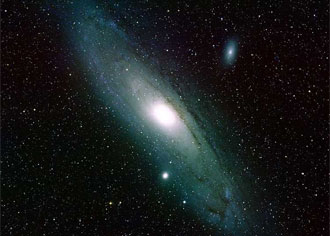They are similar in almost everything, but still there is a difference in the age of the stars in the halo
Avi Blizovsky

Astronomers describe these two galaxies as twins. Both are spiral galaxies with long spiral gas arms. Both were born in the same galactic environment (Andromeda is 2.5 million light years from Earth). Both are of similar size, shape and age. But astronomers say that Andromeda had a wilder past. Its tumultuous history may have involved collapsing into a massive galaxy or devouring smaller galaxies.
Students from Huntsville, Alabama, got a chance to prove their theory on Saturday, May 3, 2003. The evidence was found in the ages of the stars that reside at the edge of the halo of the Andromeda galaxy. Images taken by the advanced camera of the Hubble Space Telescope (ACS) showed that about a third of the stars in the halo were formed 6 to 8 billion years ago. For comparison, the age of the stars in the halo of the Milky Way is 11-13 billion years, which is close to the age of the universe.
Why are there such large differences in the ages of galaxies? Astronomers believe that a merger with another large galaxy or the ingestion of several smaller galaxies dispersed the younger stars in Andromeda's halo. The relatively young stars discovered in Andromeda's halo are richer in heavy matter than those in the Milky Way's halo, or in most of the dwarf galaxies surrounding the Milky Way. The chemical composition of the stars can show three possibilities: (1) collisions destroyed Andromeda's young disk and scattered many of its stars into the halo; (2) a single collision destroyed a relatively massive galaxy approaching Andromeda and scattered its stars and some of Andromeda's own into the halo; and (3) many of the stars formed during the collision itself.
The astronomers say that more observations will be needed to uncover more evidence of ancient violent events.
The evidence that exists to this day requires a lot of patience. Astronomers combined 250 photographic exposures of the halo stars into one image. The observations were made from December 2, 2002 to January 11, 2003, and the total exposure time was 3.5 days. Astronomers require this long observation because the Sun-like stars in the halo are too dim to be seen from most Earth-based observatories. In fact, before using Hubble's camera to locate the stars in the halo, astronomers could only observe the brighter stars. The sharp eyes of ACS revealed at least 300 stars that astronomers had not seen until now.
